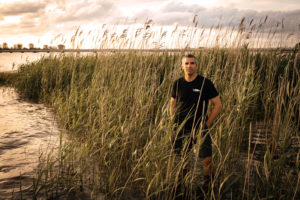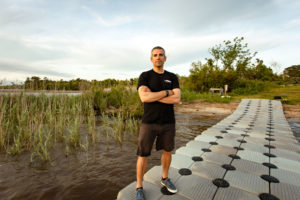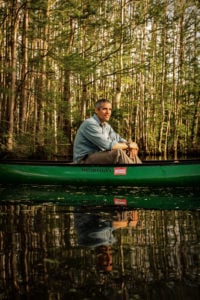Swamp Kid | Kemp Burdette, Cape Fear Riverkeeper
By: Ellen Simon
Kemp Burdette hopscotched the world, before returning to devote his life to standing up for his hometown river.

By Ellen Simon.
Photos by ©Colby Katz, courtesy of Culture Trip.
Kemp Burdette is showing a visitor a stretch of the Black River – blackwater rich with spider lily, otter, flocks of anhinga, and personal history.
That listing wreck of a houseboat? He and his dad lived on it when Kemp was in his teens.
That gutted house on stilts, stripped to the studs after the river rose 20 feet following Hurricane Florence in September 2018? His dad, an Army Corps of Engineers carpenter, built it 25 years ago. Those beams? Kemp made them from wood salvaged from a decommissioned dam. That thick-forested swampy island, the one you could kayak around in 10 minutes, with land solid enough for maybe a couple of tent platforms? His dad bought it as a gift for Kemp when he turned 21.
That stench? That’s brand new. It might be chicken waste; industrial-sized poultry operations have opened in the Cape Fear watershed only recently.
Spend time listening to almost any Waterkeeper and you can start scripting a movie, based on a true story. The one on Kemp Burdette, North Carolina’s Cape Fear Riverkeeper, would be a doozy.
First, there’s the Cape Fear River, with 6,500 miles of tributaries, enough to stretch from its mouth, just east of Wilmington, N.C., to Baghdad. Its watershed is larger than New Jersey, and encompasses everything from the Black River’s swamps, which are home to the world’s oldest cypress tree, to ditched streams inching out of huge industrial hog operations. And it’s threatened by almost every water problem in the world.
Developers are gobbling wetlands and spitting out strip malls. Dredging and sea level rise have resulted in increased salinity, which is killing stands of cypress, leaving behind ghost forests of dead trees. A DuPont spin-off spent four decades secretly releasing a toxic compound called GenX just upstream from the intake pipe for Wilmington’s drinking water.
No watershed in the world has a higher density of industrial pork-growers than the Cape Fear, where five million hogs live cheek-to-rump. These crowded, foul-smelling operations are to the idyllic red-barn family farm what a multinational steel smelter is to a blacksmith shop. All the pigs and all their poop are crammed onto the area’s hurricane-prone floodplain. The nearly 500 million gallons of waste is stored, untreated, in Olympic-swimming-pool sized open-air cesspools. Breached, overflowing cesspools are accidents that have already happened, and are waiting to happen again. After Hurricane Florence, Kemp says, “The river stunk for a month. Stunk so bad, you could barely walk in downtown Wilmington. Dead fish were everywhere.”
A ballooning poultry industry, its chickens and turkeys crammed into barns every bit as crowded as the hogs’, is also infesting the watershed, operating under such scant state regulation that government agencies don’t even know where the poultry barns are.

Then, there’s the movie’s protagonist, Kemp.
Navy rescue swimmer, Fulbright Scholar, Peace Corps volunteer, Kemp Burdette has swum the waters of the Marianas Trench, helped save the crew of a burning Japanese fishing boat, and helped uncover illegal dumping by Duke Energy, America’s largest utility, with the aid of video shot on a mobile phone wrapped in the cover of a Bible.
If this makes you envy him, consider: he’s genuinely nice and rather modest, slightly reserved, unflappable. He coaches his two daughters’ soccer teams; chops basil when his lady friend, Krissy Kasserman, National Factory Farms Campaigner at Food & Water Watch, makes pizza, and fights like a water moccasin to protect the Cape Fear and its tributaries. To prepare for these fights, he works out at 6 a.m. each day at a YMCA and watches Bruce Lee movies, where one wiry guy calmly takes on 50.
“After Hurricane Florence, the river stunk for a month. Stunk so bad, you could barely walk in downtown Wilmington. Dead fish were everywhere.”
If Kemp were an adult character in a novel, he’d be Carl Hiassen’s swamp-smart eco-warrior, Skink. If he were a child character, he’d be Huck Finn. On a TV news program, he’d be introduced by Rachel Maddow.
In fact, he was. She remarked, “I do not say this often, but check this guy out. His name is Kemp Burdette. Kemp Burdette, he`s a Riverkeeper…”
THE BLACK RIVERKEEPER
Kemp Magnus Wilkes Burdette (his dad’s name is Wilkes; Magnus was a great grandfather) was not a well-behaved child. He was a swamp kid, and nothing in school interested him as much as working his way as far up the Black River and its cypress swamps as possible. He cut class a lot. When he wasn’t in the swamp, he was in the history room at Wilmington, N.C. public library, studying old maps.
One of nearby Wrightsville Beach’s youngest ever ocean-rescue swimmers, his academic record suggested … something other than academics. Like the Navy. It was as good a place as any for a water-kid itching to see the world; one who’d lived, for a time, on a boat.
He enlisted, won his boot camp class’s Ironman competition, qualified as a rescue swimmer, and was shipped to San Diego for four months of training. He learned to jump out of a helicopter into rough seas, disentangle ejected pilots from the lines of their parachutes, extract crashed, sunken pilots out of their face masks and 400-pound seats, and provide in-the-water critical care. After graduation, he rescued the crew of that fishing boat — from a life raft — and retrieved a lot of dummy missiles in extremely rough seas.
Post-Navy, he decided that he had something to prove academically, and enrolled at the University of North Carolina, Wilmington.
“I slept in the library, practically,” he says.
He won departmental scholarships in history and geology. His senior honors thesis was about the ballast rocks on Cape Fear’s Campbell Island. Everything in that part of the state is sand eroded from the Appalachians, which were once higher than the Himalayas. Nature left no rocks in North Carolina east of Raleigh; every rock in this part of the state came from someplace else. Starting in colonial times, tall ships arriving in the port of Wilmington and making their way upriver dumped ballast stones on places like Campbell Island. The streets of Wilmington, at the time, were paved with ballast.
Kemp’s paper disproved a Harvard geologist’s theory about the origins of some of the stones, which were made of silica from the dissolved skeletons of marine plankton. The esteemed geologist claimed they were from the Cliffs of Dover. Instead, Kemp proved that some of the fossils in these ballast stones were from the Caribbean. The paper was published in the journal “Southeastern Archeology,” and remains one of the world’s most-cited papers on ballast.
It helped Kemp win a Fulbright Scholarship, which took him to his next port of call: Newfoundland, where he studied the crash of the province’s fishing industry. It began with waters once so rich with fish it was hard to sail through them, and ended after ever-larger ships and their nets depleted the fishing stocks, devastating the people and leaving them with little but alcohol, drugs, and stories of better days.
It was then, Kemp recalls, that he decided he had to fight to protect what he loved. He remembered a book he’d read in college, one of the few he’d brought with him to Newfoundland. He’d heard Robert F. Kennedy, Jr. speak in Wilmington about “The Riverkeepers,” which Kennedy had co-authored with the first Riverkeeper, John Cronin. Waiting in line to get his copy signed, Kemp thought of the river he loved best, the Black River, which fed into the Cape Fear.
“I asked him to sign my book, ‘To the Black Riverkeeper.’ He looked at me like, ‘You little dipshit!’” Kemp recalls.
But Kennedy signed it. “And now I am the Black Riverkeeper,” Kemp says.
A SENSE OF HISTORY
Kemp Burdette is speaking to the monthly meeting of the 550-member North Brunswick Newcomers Club, right after the guy who owns House of Pickleball.

Brunswick, North Carolina is the fourth-fastest growing county in the United States, flooded with so many Northern retirees that Newcomers, one of several similar clubs, graduate after three years to make room for newer Newcomers. Leland, where its meetings are held, was for most of Kemp’s life an unregistered-cars-on-blocks-with-Confederate-flag-decals-on-the-rear-windows type of place. Now it supports a brand-new, sun-drenched Cultural Arts Center.
For the House of Pickleball, Newcomers meetings are like a pond stocked with potential customers. For Kemp, it will be a good outing if he catches one supporter.
There’s plenty he could say. He could tell the crowd about the eight-year fight Cape Fear River Watch and partners successfully waged against Titan Cement, defeating a proposed coal-burning factory that would have sucked 20 million gallons of freshwater a day from the local aquifer.
He could talk about how his love for old maps, kindled in the Wilmington public library, led him to a canal alongside a Duke Power coal plant cooling pond, and how he asked Waterkeeper Alliance senior advisor Rick Dove, a Vietnam War vet, to fly over that plant. And how Dove photographed a truck pumping noxious liquid from the pond into an adjacent canal.
He could tell how the next day he popped into his flat-bottomed jonboat with two staff members from Waterkeeper Alliance, and bushwhacked through overgrowth to the canal until they motored up to a Duke employee on a bridge, who warned them, “Your cruise stops here.” How Kemp turned the boat around, as if to go away quietly, then made a U-turn, revved up the motor, hopped over a boom, and made his way up the canal, Bruce Lee with the brio of the Dukes of Hazzard. How a uniformed sheriff waiting on the bridge on their way back informed them that the water belonged to Duke, as one of his companions shot video of him with her phone in its Bibleshaped case. And how the encounter made it to the Rachel Maddow show on MSNBC.
He could tell them how his organization, Cape Fear River Watch, was part of a phalanx of activists who waged a successful fight with Duke Power over coal ash, leading the company to plead guilty to nine felony counts, one of which was the illegal dumping of 61 million gallons of effluent into that canal, which is just upstream from a drinking-water intake that serves the town of Sanford, N.C. How Duke and its subsidiaries agreed to pay $102 million in fines and restitution. And how the sheriff’s office apologized.
He could tell them how fish in 11,000-acre man-made Sutton Lake, a local fishing spot, had been deformed by Duke’s discharges of dangerous levels of selenium. How he and an old friend nicknamed “Nature Boy” waded neck-deep into the lake with seine nets, caught 400 fish and delivered them to a Wake Forest University professor, whose microscopic studies proved that the selenium had caused deformities of the fishes’ spines, mouths and gills so severe that one-fourth of them would never reach adulthood.
Or how DuPont spun off a company, Chemours, to manufacture GenX, used in the production of Teflon, knew it was toxic, and, nevertheless spent four decades pumping wastewater containing GenX into the Cape Fear. How Riverkeeper, working with the Southern Environmental Law Center, sued the state, then the company, and won a consent decree requiring Chemours to pay a $12 million penalty, stop discharging its wastewater into surface waters, and cut toxic-air emissions by 99 percent.
Or how Cape Fear River Watch staff are wrestling alligators out of swamps, because they’re at the top of the food chain, to test them for GenX. (They’re using marlin-grade fishing rods, 200-pound lines, weighted barbless hooks, and duck tape.) Or how the organization is recruiting 400 people in Wilmington to give blood, urine, and home drinking water samples as part of a health study on GenX funded by the National Institutes of Environmental Health.
He could tell them about the thousands of hours he’s spent fighting factory hog and poultry operations that pollute neighbors’ well-water with their waste; how, disproportionately, African- American, Native American, and Latino neighbors can’t enjoy iced tea on their porches or hang their wash out to dry because the spray of untreated hog waste sends literal storms of putrid, noxious mist into the wind, while the poultry operations leave giant hills of waste to bake in the sun, or wash into the river when it rains.
But, looking out at the auditorium crowded with retirees in pastel golf shirts, Kemp goes a different route.
This, he reasons, is a crowd that will respond best to pictures of the animals that depend on these waters. So that’s what he gives them. At the slide of a mother deer and her fawn, the audience coos.
Afterward, the man who looked the most interested joins a small group waiting to ask him questions. His question: Would a reverse-osmosis filter — to remove noxious particles — be best to guarantee him and his wife clean water?
Kemp responds evenly, fairly, in a way that won’t offend him, saying that no one should have to spend thousands to ensure their own clean water; that the real responsibility rests with the polluter, who should be paying to ensure clean drinking water for everyone.
What he’s found is that after he leaves, some of the Newcomers will sign up for the Cape Fear River Watch newsletters. Then maybe they’ll come out on a paddle. Then they’ll join.
Like a patient fisherman, he’s sussed out the waters, and will work for his catch as long as it takes.
Ellen Simon is Waterkeeper Alliance’s Advocacy Writer and a Contributing Editor to Waterkeeper Magazine.